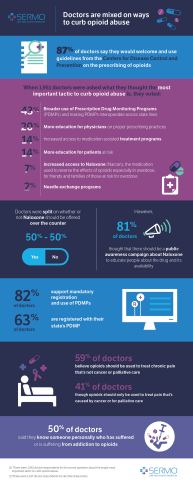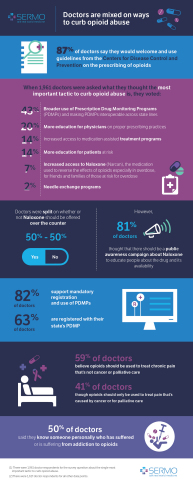NEW YORK--(BUSINESS WIRE)--SERMO, the leading global social media network exclusively for doctors and largest health care provider polling and survey company, released today the results of a new survey that found the overwhelming majority of doctors welcome guidelines from the U.S. Centers for Disease Control and Prevention (CDC) on the prescription of opioids (87 percent out of 1,617 doctors). The survey also asked 1,961 doctors what they thought was the most important tactic to curb opioid abuse and the results were as follows:
- 43% said broader use of Prescription Drug Monitoring Programs (PDMPs) and making PDMPs interoperable across state lines
- 20% said more education for physicians on proper prescribing practices
- 14% said increased access to medication assisted treatment programs
- 14% said more education for patients at risk
- 7% said increased access to Naloxone (Narcan), the medication used to reverse the effects of opioids especially in overdose, for friends and families of those at risk for overdose
- 2% said needle exchange programs
One oncologist said, “It is often impossible to know whether a patient is drug seeking, and it's hard to deny them pain meds simply because my gut tells me so. PDMPs that are across state lines would help me check my gut reaction and have strong data to decline prescriptions and/or initiate tapers.”
An urgent care physician added, “I am frequently approached by patients with "acute" complaints of pain. Since these patients are usually unknown to me, it is difficult to tell if these are truly "acute" issues versus drug seeking. PDMP is extremely helpful in differentiating these groups and making appropriate decisions.”
In support of more education for physicians, a neurologist said, “Physicians are the gateways to drugs. They have the prescription pad and ultimately they are the ones who make the call. They should be at the frontline of this epidemic and adequate education is required.”
An internal medicine specialist opined, “While there are some patients that need pain medications there are several that have now become addicted and I think physicians need more training in not only how to prescribe pain meds properly but also how to cut back appropriately as well.”
The survey included several follow up questions about PDMPs and Naloxone and found that 63 percent of 1,617 doctors surveyed were registered for their PDMP. Additionally, it found that doctors were split 50/50 on whether or not Naloxone should be offered over the counter.
An immunologist said, “Any potentially life-saving medication which can be administered by a lay person should be available OTC provided that the pharmacist provides drug information at the time of purchase.”
A family medicine practitioner added, “Heroin addicts could have easy access to this medication. Would prevent many needless deaths from patients who OD whose fellow drug users fail to take to the emergency department or fail to get them there in time.”
However, some doctors feared that making Naloxone easier to access would do the opposite as intended and lead to more drug abuse.
“Being too accessible could lead to increased overuse and abuse of opioids and it would take the physician out of the management of an addicted patient who needs further treatment,” a family physician said.
“We cannot just give this out. The users will be even more enabled to continue to use thinking they can take a drug to reverse the effects and ‘make them better’ or ‘save them,’” a gynecologist obstetrician added.
The doctors were supportive of a public awareness campaign to educate people about Naloxone and its availability (1,617 doctors responded).
The survey also examined doctors’ views about who should receive prescriptions for opioids. Fifty-nine percent out of 1,617 doctors said that they believe opioids should be used to treat chronic pain that is not cancer related or for palliative care. A previous poll of 602 physicians on the SERMO social network in August found that 50 percent said they had changed their prescribing practices because of increased awareness about the prescription drug and heroin epidemic.
The survey had personal significance to some of the doctors who responded, with 50 percent of 1,617 respondents saying they know someone personally who has suffered or is suffering from addiction to opioids.
An infographic with the full survey results can be found here.
This SERMO poll was administered via email to a random selection of members of the SERMO community in the United States. Participation was voluntary and results were kept anonymous. The margin of error is ±2.4 percent. It is calculated at the standard 95 percent confidence level. Therefore we can be 95 percent confident that the sample result reflects the active SERMO member base within the margin of error.
The question about the single most important tactic to curb opioid abuse was also posted within the SERMO social network, accounting for the larger sample size (only one vote was counted per participant). The margin of error for that question is ±2.2 percent.
About SERMO
SERMO is the leading social network for physicians - the virtual doctors’ lounge and the home of medical crowdsourcing - where doctors anonymously share their true feelings about their profession and lives and talk ‘real world’ medicine. SERMO has more than 500,000 fully verified and licensed members and is now available for doctors in fifteen countries: Argentina, Australia, Canada, Denmark, Ireland, Italy, Mexico, the Netherlands, New Zealand, Norway, South Africa, Spain, Sweden, the UK and the US. Founded in the US in 2005, SERMO's mission is to revolutionize real world medicine and to unite physicians, providing them with a safe, private and trusted platform for free and open discussions. SERMO harnesses the collective wisdom of doctors, enabling medical crowdsourcing, knowledge sharing and thus the advancement of medicine.
SERMO is also the world’s largest healthcare professional polling and survey company with 1.6 million healthcare professional members in both the social network and a digital research network, spanning 80 countries. SERMO conducts 700,000 surveys a year.
Learn more at www.SERMO.com




